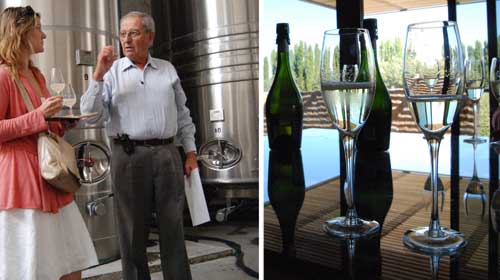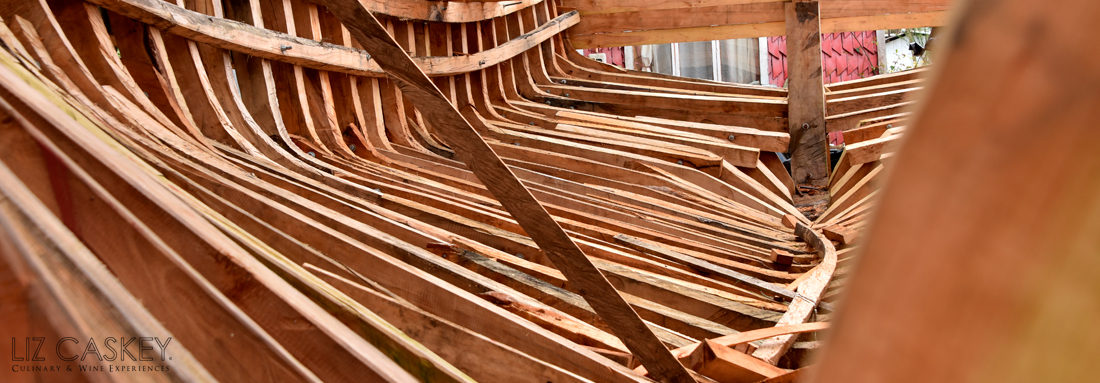
Don Pedro is frantic. The bodega alarm won’t stop shreking. It is shrill enough to hurt our ear drums a little. He greets us shrugging his shoulders and laughing in surrender. Suddenly there is silence. Meet Don Pedro Rossell–Argentina’s primo maestro in Sparkling wines. An older man in his early 70s, his smile and enthusiasm take over as he begins to share with us his “baby” and newest project—Bodega Cruzat .
Located in the Pedriel area of Mendoza, Argentina, visiting Cruzat is something of a personal journey for me. I first tried their Nature in 2008 when it was released in Chile. I was immediately smitten after the first sip. It quickly turned into our house favorite so when we planned this investigative trip, I jumped at the chance to see the place and meet the man responsible for making this wonderful drink.
As Don Pedro explains, Cruzat is a very new Project, founded in 2004 by Chilean partners Gastón Cruzat, Pedro Grand (former partner in Montes Winery), Hernán Boher, and Fernando Riera Rawling. They were looking to create one of South America’s grand sparkling wines. Don Pedro, who had been in a venture with another outstanding winery called Rosell Boher, had been reeled in after he left the partnership due to a fall out. When I first met Pedro Grand, he said, “I am going to make the best champagne in Chile and I want you to do it.” Obviously, Don Pedro, being a man of terroir, did not feel comfortable executing a new project in a place where he didn’t know the land, varieties, climate. So he proposed keeping it on Mendocino soil. The deal was sealed and Cruzat was born.
Cruzat is one of the few bodegas in Argentina and Chile dedicated exclusively to producing Ultra Premium sparking wines in the traditional French method. In Argentina, where there is a culture of drinking sparkling as an apertif, there is a huge range in quality. Much of it is dominated by big players like Chandon. In Chile, locals still associate sparkling with New Year’s and celebrations. They tend to gravitate towards sweet versions like Demi-Sec and fruit bomb Brut. Only recently are we seeing a handful of gorgeous, dry Nature wines hitting the market like Valdivieso.
Don Pedro invites us into the fermentation tank area where tall, slim tanks huddle in a corner. They use these tanks specifically for making the bases for sparkling wines to avoid oxidation as the grape musts go through the first and second fermentation, malolatic. He explains that as the wines ferment, they create layers of aroma that increase the complexity as the wines are kept on the lies. From the moment of harvest to this point is two years (or more) in its life as a still wine. This is before they even begin to move onto the magic of turning it into bubbly!
We taste a dozen or so base wines that range from the recently-harvested lots of Chardonnay (from the Espinola vineyard) with a pineapple nose topped with froth from fermentation to the future Special Edition vintage of 2005, a blend of Pinot Noir (85%) and Chardonnay (15%). This last vintage will be one to look for as only 8,000 bottles will be put out on the market. Already in this stage, it had the nose and body of a true champagne from France. I was impressed.
However, what I most loved about Don Pedro was his enthusiasm. As we tasted, he spoke how wine is about trusting your senses and intuition. “Everything in wine”, he says, “is a sensory-driven decision. You just have to taste and taste some more. No lab can pinpoint that”. Of course, it is a sensitivity that you cannot learn. No book can teach you that. You have it, you feel it, and ultimately you develop it (from within). He continues that for him, wine is a natural product and muteable. It is formed with one’s senses and creativity. It is not an intellectual pursuit. It’s all about smelling, tasting, feeling, knowing. I love this guy.
Since Cruzat makes sparkling wine with the Méthode Champenoise, we quickly head down to the cellar to see the laborious daily task of riddling the bottles. I am really blow away at the time that elapses between harvest and the final product. The average, for non-vintages is about four years. For their special addition and rosés, it will probably be 5-6 years before it gets to market. However, Don Pedro just sighs and says “That’s what you need to get the right product”.
In the tasting room, strewn with glasses from the Chilean Partners visit the previous night, we sit down to try the fruits of his labor. At 11am, this is our “second” breakfast.
Their Nature is a blend of 60% Pinot Noir and 40% Chardonnay with no residual sugar whatsoever. The nose is fresh with fruity and flowery notes like citrus fruit, quince, and even jasmin. Behind those notes are the toasty fermentation aromas so typical of the classic Champenoise method. The acidity is beautiful with tiny, consistent bubbles. It’s hard to put it down. It’s so delicious. I imagine this with the magnificent Black-lipped oysters we get in Santiago from Calbuco.
The Brut has more Pinot Noir, 75%, and only 25% of Chardonnay. He explains that the grapes are from an area with white soil so more light reflects on them. This ultimately yields grapes with more sugar and body. What strikes me about this wine immediately is that it’s sweeter and has a light smell of red fruits. In the mouth, the body is smooth and silky. It full covers your palate. Don Pedro recommends this with paté, any white meats, richer seafoods like scallops and crab, and even pasta.
And finally, the Rosé. I adore rosé (especially Ruinart). This is the first I am tasting from Argentina. Made from 90% Pinot Noir and 10% Chardonnay, it hints of fresh berries and toasted almonds. The body and acidity converge at the perfect note. The tannins are palatable, and as they say in Spanish, have “presence”. Exquisite. I think this could go with just about anything. Don Pedro thought lamb, spicy foods, raviolis, and some hearty vegetable dishes.
Francisco and I agree our favorites are the Nature and Rosé. Don Pedro generously insists we take a bottle of each. We accept. No argument here!
Cruzat today is still a very boutique operation making only about 80,000 bottles per year. There goal is to increase steadily over the next years of operation. Right now, they do export about 20% to Chile (which you can find at Mundo del Vino. It is also exported to the US although I suspect if you’d like to find it, contact the bodega first. It is a gem worth seeking out.
Bravo to the Cruzat team!












